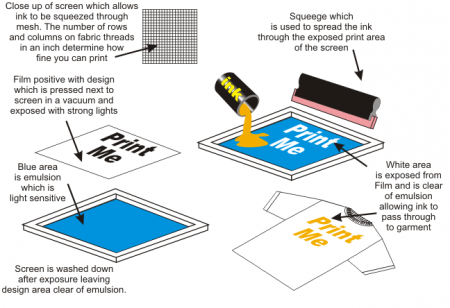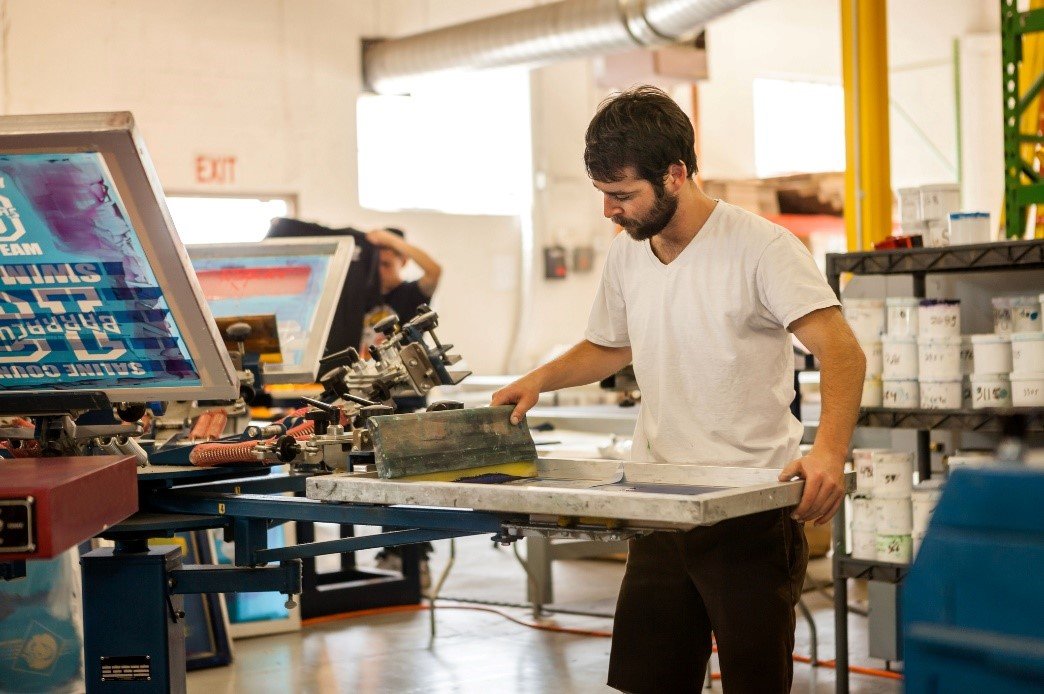10 Easy Facts About Tx Tees Explained
10 Easy Facts About Tx Tees Explained
Blog Article
The Basic Principles Of Tx Tees
Table of ContentsNot known Facts About Tx TeesRumored Buzz on Tx TeesSome Known Factual Statements About Tx Tees The Tx Tees StatementsSome Ideas on Tx Tees You Should KnowThe Facts About Tx Tees UncoveredSome Known Details About Tx Tees
That brings your total amount to approximately $1,900 prior to tax obligation and delivery. Add up various other expenses, like the number of utilities it takes to run the shop and the price of ink and emulsion per layout. custom screen printing. Take the print below. This is a one-color picture, so the cost of ink per t-shirt is approximately 20 cents.The emulsion ought to only be a few cents since you 'd just require to layer one display for this work. Usually, printers attempt to make up to 45% earnings on a print work.

With DTF, you can print a handful of t-shirts, or just one. Both screen printing and DTF have their particular niches in the globe.
An Unbiased View of Tx Tees
The most effective method to know? Ask around and see what print shops like yours are doing. screen printer. Try both out and see which you like much better
When you're picking what kind of printing method to utilize for publishing your art work layouts on your garments, it is very important that you understand the distinctions in between these 2 techniques so you can make best use of outcomes while minimizing costs. Screen printing is the most typically made use of strategy for publishing layouts on fabrics.
DTG printing is additionally referred to as place or straight to garment printing since it prints only what is needed instead of making a display as display printers do. https://txtees02.edublogs.org/2024/03/28/revolutionize-your-style-with-custom-t-shirt-design/. Screen printing functions by screen filler squeegee screen printing ink display mesh display, then moving the picture to garment using warmth and/or pressure
The DTG printer makes use of unique dye-sublimation inks that are used right into a pre-designed photo by a digital printing system. The inks enter into the material, enabling vibrant shades and phenomenal information. It's likewise known as area or direct to garment printing since it publishes only what is needed as opposed to making a screen as screen printers do.
Tx Tees Can Be Fun For Anyone
It's much faster - you can print a fullcolor photo in minutes, as opposed to hours for screen printing. Second, there's no set up time or prices entailed - you can print any kind of design you such as, without having to produce a screen. Third, there's no waste - since screen printers display print one layout each time, they need to evaluate each shade independently.
The paper is extremely costly and can just be utilized once. Once it's published on, it needs to be disposed of. - The initial acquisition rate is less than the upfront investment of DTG printers- You can publish multi-color styles one screen at a time instead of having to print each color independently like DTG printing.

An Unbiased View of Tx Tees
However, as opposed to making use of screen mesh as screen printers do, color sublimation printers make use of laser technology to move your images onto garments or paper. A heat process moves the color from its solid-state directly into the gas phase which subsequently merges it onto textile substrates when they are quickly warmed to heats under high stress.
Sublimation printing is eco-friendly. It uses much less water than screenprinting, and because it does not involve making use of unsafe solvents, it's risk-free for all kinds of garments. The color sublimation inks are additionally odor-free when healed, unlike display printers that make use of damaging chemicals during the display printing process that leave behind an unpleasant odor.
They likewise conserve cash on costly devices like exposure systems because dye sublimation printers don't require a UV exposure system or a flash treatment stove that is normally made use of in display printing (custom cap printing). What is direct to garment printing (DTG Printing)? DTG printing is an electronic screenprinting process that prints directly onto fabric making use of specialized inkjet printers
The Ultimate Guide To Tx Tees
DTG printing offers numerous advantages over conventional screenprinting, including the capacity to print photographic high quality images, better color vibrancy, and the capacity to publish styles on darker fabrics. DTG printers function by heating up the textile ink till it transforms into a gas. The gas after that penetrates the fabric, bonding with the fibers to develop a long-term print.

Screen printers just prepare their screen after that begin publishing up until they run out of product or ink.- There is a wide variety of seasoned display printers around the world, which can be handy for novices. - It's a slower procedure - screen printers typically have to wait for the learn the facts here now ink to completely dry prior to they can publish the following color- Screen printers call for manual work, so there's a higher discovering curve and it takes longer to produce a premium style- Screen printing isn't as precise as DTG printing, so you may get some "blood loss" of shades from one component of the picture onto one more if not done properly.
Getting The Tx Tees To Work
Instead of making use of screen mesh as screen printers do, dye sublimation printers make use of laser innovation to move your images onto garments or paper. A warmth process moves the dye from its solid-state straight right into the gas phase which subsequently merges it onto textile substrates when they are quickly heated to high temperatures under high pressure.
Sublimation printing is eco-friendly. It utilizes much less water than screenprinting, and because it does not entail using damaging solvents, it's secure for all kinds of clothing. The dye sublimation inks are likewise odor free when healed, unlike screen printers that use dangerous chemicals during the display printing process that leave an unpleasant odor.
They also conserve money on expensive tools like direct exposure units since color sublimation printers do not call for a UV exposure unit or a flash remedy oven that is generally utilized in display printing. What is straight to garment printing (DTG Printing)? DTG printing is an electronic screenprinting procedure that publishes directly onto material utilizing specialized inkjet printers.
The Buzz on Tx Tees
DTG printing supplies several advantages over typical screenprinting, including the ability to print photo top quality photos, higher color vibrancy, and the capability to print designs on darker textiles. DTG printers function by heating up the fabric ink until it becomes a gas. The gas then permeates the textile, bonding with the fibers to develop a long-term print.
Report this page